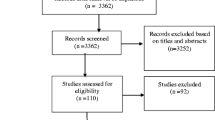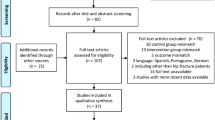Abstract
In the fast-growing geriatric population, we are confronted with both osteoporosis, which makes fixation of fractures more and more challenging, and several comorbidities, which are most likely to cause postoperative complications. Several models of shared care for these patients are described, and the goal of our systematic literature research was to point out the differences of the individual models. A systematic electronic database search was performed, identifying articles that evaluate in a multidisciplinary approach the elderly hip fracture patients, including at least a geriatrician and an orthopedic surgeon focused on in-hospital treatment. The different investigations were categorized into four groups defined by the type of intervention. The main outcome parameters were pooled across the studies and weighted by sample size. Out of 656 potentially relevant citations, 21 could be extracted and categorized into four groups. Regarding the main outcome parameters, the group with integrated care could show the lowest in-hospital mortality rate (1.14%), the lowest length of stay (7.39 days), and the lowest mean time to surgery (1.43 days). No clear statement could be found for the medical complication rates and the activities of daily living due to their inhomogeneity when comparing the models. The review of these investigations cannot tell us the best model, but there is a trend toward more recent models using an integrated approach. Integrated care summarizes all the positive features reported in the various investigations like integration of a Geriatrician in the trauma unit, having a multidisciplinary team, prioritizing the geriatric fracture patients, and developing guidelines for the patients’ treatment. Each hospital implementing a special model for geriatric hip fracture patients should collect detailed data about the patients, process of care, and outcomes to be able to participate in audit processes and avoid peerlessness.

Similar content being viewed by others
Abbreviations
- ADL:
-
Activities of daily living
- IADS:
-
Instrumental activities of daily living
References
Friedman S, Mendelson D, Kates S, McCann R (2008) Geriatric co-management of proximal femur fractures: total quality management and protocol-driven care result in better outcomes for a frail patient population. J Am Geriatr Soc 56:1349–1356
Hempsall VJ, Robertson DR, Campbell MJ, Briggs RS (1990) Orthopaedic geriatric care—is it effective? A prospective population-based comparison of outcome in fractured neck of femur. J R Coll Physicians Lond 24:47–50
Handoll HH, Cameron ID, Mak JC, Finnegan TP (2009) Multidisciplinary rehabilitation for older people with hip fractures. Cochrane database of systematic reviews (online). CD007125
Cameron ID, Handoll HH, Finnegan TP, Madhok R, Langhorne P (2001) Co-ordinated multidisciplinary approaches for inpatient rehabilitation of older patients with proximal femoral fractures. Cochrane Database of Systematic Reviews (online). CD000106
Pioli G, Giusti A, Barone A (2008) Orthogeriatric care for the elderly with hip fractures: where are we? Aging Clin Exp Res 20:113–122
Kennie DC, Reid J, Richardson IR, Kiamari AA, Kelt C (1988) Effectiveness of geriatric rehabilitative care after fractures of the proximal femur in elderly women: a randomised clinical trial. BMJ 297:1083–1086
Naglie G, Tansey C, Kirkland JL, Ogilvie-Harris DJ, Detsky AS, Etchells E, Tomlinson G, O’Rourke K, Goldlist B (2002) Interdisciplinary inpatient care for elderly people with hip fracture: a randomized controlled trial. Can Med Assoc J 167:25–32
Swanson CE, Day GA, Yelland CE, Broome JR, Massey L, Richardson HR, Dimitri K, Marsh A (1998) The management of elderly patients with femoral fractures. A randomised controlled trial of early intervention versus standard care. Med J Aust 169:515–518
Gilchrist WJ, Newman RJ, Hamblen DL, Williams BO (1988) Prospective randomised study of an orthopaedic geriatric inpatient service. BMJ 297:1116–1118
Stenvall M, Olofsson B, Nyberg L, Lundström M, Gustafson Y (2007) Improved performance in activities of daily living and mobility after a multidisciplinary postoperative rehabilitation in older people with femoral neck fracture: a randomized controlled trial with 1-year follow-up. Journal of Rehabilitation Medicine: Official Journal of the UEMS European Board of Physical and Rehabilitation Medicine 39:232–238
Shyu YI, Liang J, Wu CC, Su JY, Cheng HS, Chou SW, Chen MC, Yang CT (2008) Interdisciplinary intervention for hip fracture in older Taiwanese: benefits last for 1 year. J Gerontol A Biol Sci Med Sci 63:92–97
Shyu YI, Liang J, Wu CC, Su JY, Cheng HS, Chou SW, Yang CT (2005) A pilot investigation of the short-term effects of an interdisciplinary intervention program on elderly patients with hip fracture in Taiwan. J Am Geriatr Soc 53:811–818
Vidán M, Serra JA, Moreno C, Riquelme G, Ortiz J (2005) Efficacy of a comprehensive geriatric intervention in older patients hospitalized for hip fracture: a randomized, controlled trial. J Am Geriatr Soc 53:1476–1482
Zuckerman JD, Sakales SR, Fabian DR, Frankel VH (1992) Hip fractures in geriatric patients. Results of an interdisciplinary hospital care program. Clin Orthop Relat Res 213–225
Antonelli Incalzi R, Gemma A, Capparella O, Bernabei R, Sanguinetti C, Carbonin PU (1993) Continuous geriatric care in orthopedic wards: a valuable alternative to orthogeriatric units. Aging (Milan, Italy) 5:207–216
Khan R, Fernandez C, Kashifl F, Shedden R, Diggory P (2002) Combined orthogeriatric care in the management of hip fractures: a prospective study. Ann R Coll Surg Engl 84:122–124
Roberts HC, Pickering RM, Onslow E, Clancy M, Powell J, Roberts A, Hughes K, Coulson D, Bray J (2004) The effectiveness of implementing a care pathway for femoral neck fracture in older people: a prospective controlled before and after study. Age Ageing 33:178–184
Koval KJ, Chen AL, Aharonoff GB, Egol KA, Zuckerman JD (2004) Clinical pathway for hip fractures in the elderly: the Hospital for Joint Diseases experience. Clin Orthop Relat Res 72–81
Fisher AA, Davis MW, Rubenach SE, Sivakumaran S, Smith PN, Budge MM (2006) Outcomes for older patients with hip fractures: the impact of orthopedic and geriatric medicine cocare. J Orthop Trauma 20:172–178, discussion 179-180
Adunsky A, Lusky A, Arad M, Heruti RJ (2003) A comparative study of rehabilitation outcomes of elderly hip fracture patients: the advantage of a comprehensive orthogeriatric approach. J Gerontol A Biol Sci Med Sci 58:542–547
Khasraghi FA, Christmas C, Lee EJ, Mears SC, Wenz JF Sr (2005) Effectiveness of a multidisciplinary team approach to hip fracture management. J Surg Orthop Adv 14:27–31
Boyd RV, Hawthorne J, Wallace WA, Worlock PH, Compton EH (1983) The Nottingham orthogeriatric unit after 1000 admissions. Injury 15:193–196
Cogan L, Martin AJ, Kelly LA, Duggan J, Hynes D, Power D (2010) An audit of hip fracture services in the Mater Hospital Dublin 2001 compared with 2006. Ir J Med Sci 179:51–55
Adunsky A, Arad M, Levi R, Blankstein A, Zeilig G, Mizrachi E (2005) Five-year experience with the ‘Sheba’ model of comprehensive orthogeriatric care for elderly hip fracture patients. Disabil Rehabil 27:1123–1127
Friedman SM, Mendelson DA, Bingham KW, Kates SL (2009) Impact of a comanaged Geriatric Fracture Center on short-term hip fracture outcomes. Arch Intern Med 169:1712–1717
Adunsky A, Levy R, Heim M, Mizrahi E, Arad M (2003) The unfavorable nature of preoperative delirium in elderly hip fractured patients. Arch Gerontol Geriatr 36:67–74
Shiga T, Wajima Zi, Ohe Y (2008) Is operative delay associated with increased mortality of hip fracture patients? Systematic review, meta-analysis, and meta-regression: [Le delai operatoire est-il associe a une mortalite accrue chez les patients atteints d’une fracture de la hanche? Synthese systematique, meta-analyse et meta-regression]. Can J Anaesth 55:146–154
Rae HC, Harris IA, McEvoy L, Todorova T (2007) Delay to surgery and mortality after hip fracture. ANZ J Surg 77:889–891
Egol KA, Strauss EJ (2009) Perioperative considerations in geriatric patients with hip fracture: what is the evidence? J Orthop Trauma 23:386–394
Bryant DM, Sanders DW, Coles CP, Petrisor BA, Jeray KJ, Laflamme GY (2009) Selection of outcome measures for patients with hip fracture. J Orthop Trauma 23:434–441
Conflicts of interest
Financial disclosures: C. Kammerlander, teaching activities with Synthes; T. Roth, none; S.M. Friedman, none; N. Suhm, consultancy agreement with Synthes, teaching activities for Synthes, Lilly, MSD and Roche, and a research grant from Synthes and MSD; T.J. Luger, none; U. Kammerlander-Knauer, none; D. Krappinger, none; M. Blauth, performs consultant and teaching activities with Synthes. The authors declare no further conflicts of interest.
Author information
Authors and Affiliations
Corresponding author
Rights and permissions
About this article
Cite this article
Kammerlander, C., Roth, T., Friedman, S.M. et al. Ortho-geriatric service—a literature review comparing different models. Osteoporos Int 21 (Suppl 4), 637–646 (2010). https://doi.org/10.1007/s00198-010-1396-x
Received:
Accepted:
Published:
Issue Date:
DOI: https://doi.org/10.1007/s00198-010-1396-x




